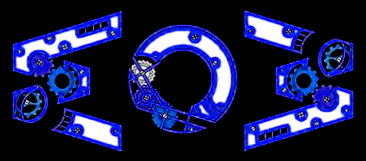|
Northern Central
Europe 
Republic of Poland

Poland Warsaw 
The history of human activity on Polish soil spans thousands of years.
Throughout the late antiquity period it became extensively diverse, with various cultures and tribes settling on the vast Central European Plain. 
Warsaw variant name for Polish Warszawa, is the capital and largest city of Poland. The metropolis stands on the Vistula River in east-central Poland. 
Warsaw Republic of Poland 2012
 The city rose to prominence in the late 16th century, when Sigismund III decided to move the Polish capital and his royal court from Krakow. 
The Palace of Culture and Science (Polish: Pałac Kultury i Nauki, also PKiN) is the tallest building in Poland, the eighth tallest building in the European Union. 
The building was originally known as the Joseph Stalin Palace of Culture and Science (Pałac Kultury i Nauki imienia Józefa Stalina). 
As the city's most visible landmark, the building was controversial from its inception. Many Poles initially hated the building because they considered it to be a symbol of Soviet domination, and at least some of that negative feeling persists today. 
Stalin's name was removed from the interior lobby and one of the building's sculptures. 
Warsaw Republic of Poland

In 2011, Warsaw was ranked the world's 46th most expensive city to live in, and was classified as an Alpha- world city. 
Warsaw, especially its city centre, Srodmiescie, is home not only to many national institutions and government agencies, but also to many domestic and international companies. 
Warsaw's ever-growing business community has been noticed globally, regionally, and nationally. 
Warsaw produces 12% of Poland's national income. 
Warsaw leads the region of Central Europe in foreign investment and in 2006 GDP growth met expectations with a level of 6.1%. 
At the same time the unemployment rate is one of the lowest in Poland, not exceeding 3%, according to the official figures. 
The number of state-owned enterprises continues to decrease while the number of companies operating with foreign capital is on the rise, reflecting the continued shift towards a modern market-based economy. 
Warsaw Central (Warszawa Centralna) is the most important railway station in Warsaw, Poland. Its construction was completed in 1975. 
The station, located on the Warsaw Cross-City Line, has four underground island platforms (eight tracks in total) and is served by long-distance domestic and international trains of PKP Intercity and Przewozy Regionalne as well as some of the regional trains operated by Koleje Mazowieckie 
Warsaw has the biggest concentration of electronics and high-tech industry in Poland, while the growing consumer market perfectly fosters the development of the food-processing industry. 
Zarząd Transportu Miejskiego (lit. Municipal Transport Authority, translated as Warsaw Transport Authority ZTM). 
ZTM is the local authority controlled body managing all means of public transport in Warsaw. 
The public transport companies running the lines governed by the ZTM are: Tramwaje Warszawskie (Warsaw Tramways), Miejskie Zakłady Autobusowe (Urban Bus Works), Warsaw Metro, Szybka Kolej Miejska. 
Public transport in Warsaw includes buses, trams (streetcars), Metro, light rail Warszawska Kolej Dojazdowa line, urban railway Szybka Kolej Miejska, regional rail Koleje Mazowieckie (Mazovian Railways), and bicycle sharing systems (Veturilo and Bemowo Bike). 
Warsaw Republic of Poland

The architecture of Warsaw has influenced and reflected the history of Polish architecture. 
The city of Warsaw features prominent buildings in a variety of styles by many important architects. 
Buildings are representatives of nearly every European architectural style and historical period. 
Warsaw Republic of Poland

The Royal Castle in Warsaw (Zamek Krolewski w Warszawie) is a castle residency and was the official residence of the Polish monarchs. 
It is located in the Castle Square, at the entrance to the Warsaw Old Town. 
Warsaw's Old Town (Polish: Stare Miasto) is the oldest historic district of the city. 
The heart of the area is the Old Town Market Place, with its restaurants and shops. Surrounding streets feature medieval architecture such as the city walls, the Barbican and St. John's Cathedral. 
Warsaw's palaces, churches and mansions display a richness of color and architectural details. 
The Warsaw barbican (barbakan warszawski, semicircular fortified outpost) one of few remaining relics of the complex network of fortifications that once encircled Warsaw. 
The city has examples of architecture from the gothic, renaissance, baroque and neoclassical periods, located within easy walking distance of the town centre. 
The Łazienki Palace (Polish: pałac Łazienkowski) also called the Palace on the Water and the Palace on the Isle is a Neoclassical palace in Warsaw's Royal Baths Park. 
The building began as a bathhouse for Stanisław Herakliusz Lubomirski, owner of adjacent Ujazdow Castle. 
The palace is built on an artificial island that divides the lake into two parts, a smaller northern lake and a larger southern one. The palace is connected to the surrounding park by two Ionic colonnaded bridges. 
Greenspace covers 25% of the surface area of Warsaw, including a broad range of greenstructures, from small neighborhood parks, green spaces along streets and in courtyards, trees and avenues to large historic parks, nature conservation areas and the urban forests at the fringe of the city. 
Pierogi are dumplings of unleavened dough, first boiled, then they are baked or fried usually in butter with onions, traditionally stuffed with potato filling, sauerkraut, ground meat, cheese, or fruit. 

|















